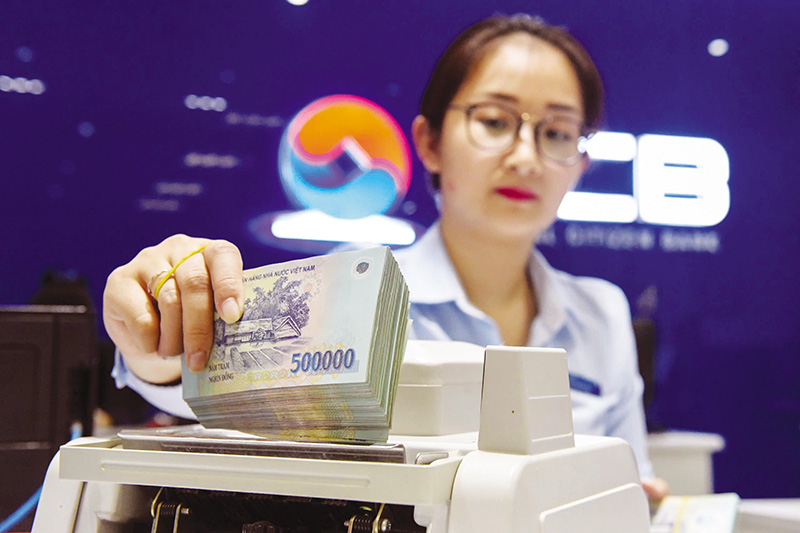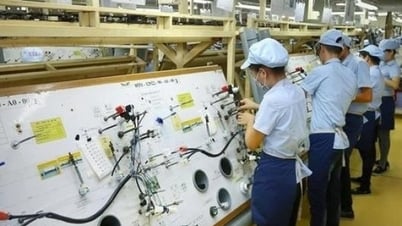 |
| Needing capital to expand growth, many banks increase capital through stock dividends. Photo: Duc Thanh |
Capital mobilization declines, banks worry about interest rate increase
The State Bank's report shows that in January 2025, capital mobilization from residents and economic organizations of the entire banking system grew negatively (down 0.75% compared to the end of 2024). In the first month of the year, although residential deposits still increased by VND 123,000 billion, it could not compensate for the decrease of VND 233,000 billion from economic organizations (down 3.04% compared to the previous month). Thus, after 5 consecutive months of increase, capital mobilization from economic organizations recorded a decrease.
Speaking to Dau Tu Newspaper reporters, the Deputy General Director of a large joint stock commercial bank said that the bank has been making great efforts to mobilize capital again since the beginning of 2025 to prepare capital sources for growth. The growth rate of capital mobilization is higher than the same period last year, but still lower than credit growth. The bank's observations also show that a large amount of deposits are shifting to gold and real estate.
According to the General Statistics Office (Ministry of Finance), as of March 25, 2025, capital mobilization of credit institutions increased by 1.36%, credit in the whole economy increased by 2.49%. Thus, as of March 25, the gap between mobilization and lending of the banking system had reached VND 1.1 million billion. By this time, the gap may be higher.
Gold has continuously broken historical peaks, real estate prices have skyrocketed since the beginning of the year, while savings interest rates remain low, making many people impatient. Fomo syndrome (fear of missing out) has caused many people to switch from saving to gold and land, regardless of the risks.
In a report recently sent to the National Assembly's Economic and Financial Committee, the State Bank admitted that interest rates will face many pressures in the coming time.
First, lending interest rates have fallen sharply in recent times.
Second, the demand for credit capital for production, business and consumption is expected to increase strongly in the coming time to meet the economic growth target for 2025, while capital mobilization of the entire credit institution system may be affected and compete with other investment channels, such as real estate, gold, and the stock market.
Third, global interest rates tend to decrease, but remain high and global financial markets are unpredictable after the US imposed reciprocal tariffs on countries.
From the time the State Bank met with commercial banks (February 25, 2025) to early April 2025, 26 banks lowered their deposit interest rates by 0.1-1.05%, depending on the term. However, on average, the deposit interest rates of banks have not decreased significantly. Accordingly, the average lending interest rate for new transactions of commercial banks by the end of March 2025 only decreased by 0.2%/year compared to the end of 2024.
Urgently increase capital, mobilize bonds to have a source of loans
Mr. Tran Minh Binh, Chairman of the Board of Directors of VietinBank, said that in 2025, interest rate pressure on the State Bank and the credit institution system will certainly be greater than last year.
“Interest rates have increased slightly since last year and are still on an upward trend,” said Mr. Binh.
 Deposit interest rates will increase at some point, but this year, the expected interest rate will remain low. I believe that this year, the liquidity of the banking system will be basically stable thanks to the SBV continuing to implement a proactive and flexible monetary policy with the top priority being to promote economic growth. In addition, public investment disbursement has increased sharply and FDI capital has been maintained. In addition, increased risks in the international and domestic financial markets may cause money to flow to the deposit channel as a safe channel.
Deposit interest rates will increase at some point, but this year, the expected interest rate will remain low. I believe that this year, the liquidity of the banking system will be basically stable thanks to the SBV continuing to implement a proactive and flexible monetary policy with the top priority being to promote economic growth. In addition, public investment disbursement has increased sharply and FDI capital has been maintained. In addition, increased risks in the international and domestic financial markets may cause money to flow to the deposit channel as a safe channel. 
- Dr. Can Van Luc, Chief Economist of BIDV
Although the interest rate level at VietinBank is still under control, VietinBank's leaders believe that with the current interest rate developments, the bank's net interest margin (NIM) will be under downward pressure in 2025. The reason is that capital costs tend to increase, while the bank continues to implement preferential credit packages and support programs for businesses and people according to the policies of the Government and the State Bank .
Previously, Deputy Governor of the State Bank Dao Minh Tu also affirmed that the banking sector lends more to the economy than the mobilized balance, the shortfall must use both equity capital and re-lending capital from the State Bank .
In the context of capital need to expand growth, many banks are increasing capital with record high stock dividend rates. For example, Vietcombank set the stock dividend rate at 49.5%. This figure at VietinBank is 44.64%, at MSB is 20%.
During this year's general meeting of shareholders, most banks presented shareholders with plans to increase capital, such as MB paying dividends in shares at a rate of 32%, helping to increase charter capital. NCB has been approved by shareholders to increase charter capital by an additional VND7,500 billion through the offering of 700 million individual shares, equivalent to 59.42% of NCB's charter capital at the time of offering. VietABank presented a historic capital increase plan (increasing by 115%, from VND5,399.6 billion to VND11,582.4 billion...
In addition, banks are also actively issuing bonds to raise capital. According to statistics from the Vietnam Bond Market Association, from the beginning of the year to mid-April 2025, bond issuance reached VND41,621 billion, of which more than 60% of the value belonged to the banking group.
FiinGroup analysts believe that although many banks have plans to increase equity capital (tier 1 capital), increasing tier 1 capital takes a long time and depends on the stock market situation. Therefore, banks will continue to aggressively issue bonds in the coming time to meet credit growth requirements as well as capital safety indicators.
The State Bank's report shows that in January 2025, although capital mobilization from the population and credit institutions decreased, the total means of payment of the whole system still increased by 1.46%. This shows that the issuance of valuable papers by credit institutions continues to increase in the context of capital mobilization showing signs of decline.
Source: https://baodautu.vn/tien-gui-bi-hut-khoi-ngan-hang-suc-ep-lai-suat-lai-tang-d273077.html


![[Photo] Prime Minister Pham Minh Chinh receives Swedish Minister of International Development Cooperation and Foreign Trade](https://vphoto.vietnam.vn/thumb/1200x675/vietnam/resource/IMAGE/2025/5/12/ae50d0bb57584fd1bbe1cd77d9ad6d97)


![[Photo] Prime Minister Pham Minh Chinh starts construction of vital highway through Thai Binh and Nam Dinh](https://vphoto.vietnam.vn/thumb/1200x675/vietnam/resource/IMAGE/2025/5/12/52d98584ccea4c8dbf7c7f7484433af5)

![[Photo] Prime Minister Pham Minh Chinh works with the Standing Committee of Thai Binh Provincial Party Committee](https://vphoto.vietnam.vn/thumb/1200x675/vietnam/resource/IMAGE/2025/5/12/f514ab990c544e05a446f77bba59c7d1)


















































































Comment (0)